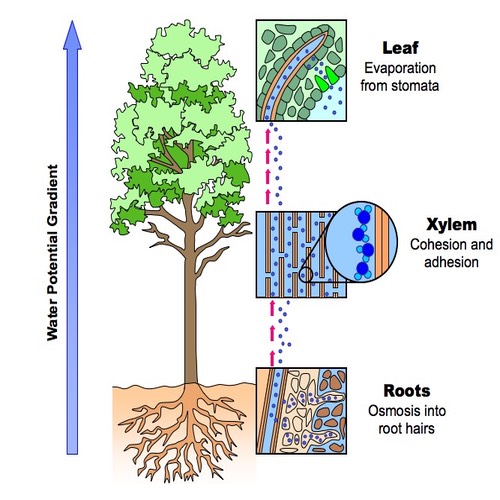Describe the Cohesion-tension Theory of Water Transport in the Xylem
- Water evaporates from leaves transpiration - This creates tension suction pulling more water up the lead. The reason water is able to travel up the xylem is due to the tension created.

17 1 3 Cohesion Tension Theory Biology Libretexts
Water molecules stick together via hydrogen bonds in a process known as COHESION.

. This is often referred to as the cohesionadhesion or cohesiontension theory of water transport. Page 1 of 77 Q1. This theory is quite convincing and has been widely accepted.
This theory was given by Henry Dixon in 1914. These cohesive and adhesive force works together to form an. Water from the roots is pulled up by this tension.
The potometer is shown in Figure 1As water is lost from the shoot it is replaced by water from the capillary tube. Evaporation exerts force causing tension in water columns Cohesion holds water column together Adhesion between walls of the xylem and the water molecules results in a pulling force which causes the water columns to decrease in volume Hence the xylem vessels and the tree trunk both become narrower. The attraction of water to other water molecules or cohesion allows water to pull other water molecules up through the xylem.
The cohesion-tension theory suggests that water is obtained in plants from soil due to the fact that water is cohesive and so is able to be drawn up from soil particles into the root hairs via osmosis. Cohesion - Tension Model of Xylem Transport The Cohesion Tension model of water transport in xylem can be outlined as followed Objective. 5 Total 10 marks Q2.
The attractionbetween a water molecule and the wall of the xylem element is called adhesion. An important factor which can discontinue the water column is the introduction of air bubbles in the xylem. Cohesion-tension theory was proposed by Dixon and Jolly in 1894.
Main factor responsible for movement of water up xylem Water evaporates from mesophyll cells due to sun causing transpiration Water molecules form hydrogen bonds between one another Thus water molecules tend to stick together This is known as cohesion Water forms a continuous unbroken column across mesophyll cells and. The cohesion-tension theory describes how water moves from the roots to the leaf. At night when stomata shut and transpiration stops the water is held in the stem and leaf by the adhesion of water to the cell walls of the xylem vessels and tracheids and the cohesion of water molecules to each other.
SO whole column of water moves upwards. As the name suggests the cohesion theory is based on the force of cohesion between water molecules. A student used a potometer to measure the movement of water through the shoot of a plant.
This is called the cohesiontension theory of sap ascent. - Water molecules are cohesive stick tougher due to H bonds so when some are pulled up others follow. It is as though water molecules are sucked up to the leaves like a straw.
Capillary action occurs when a narrow tube pulls. The water column cannot be broken or pulled away from the xylem walls because of cohesion and adhesion of water. Transpiration of water through stomata creates low potential at the top of the xylem.
Water is then able to move through to neighbouring cortex cells by osmosis until it reaches the xylem. The cohesion of water One way to visualize the importance of cohesion and adhesion in water movement through xylem is to look at how water moves through narrow tubes called capillary tubes. Water from the soil reaches the plants xylem of roots against gravity due to osmosis.
Water molecules have a strong mutual force of attraction called cohesive forcedue to which they cannot be easily separatedfrom one another. This forms a continuous water column throughout the xylem vessels of the plant from the top to the root. Due to the hydrogen bonding between the water.
A theory that describes the water movement from the roots of the plants to its leaves is the cohesion tension mechanism. CohesionAdhesion or CohesionTension Theory of Water Movement The cohesionadhesion theory sometimes also called cohesiontension theory describes the two forces in the xylem vessels that help transport water upward against gravity from the roots to. Outline the role of the xylem in the movement of water through a plant describe theories for the ascent of water including root pressure capillary action and imbibition explain how the cohesiontension cohesionadhesion theory can be used to describe the movement of water in the xylem compare the different theories of water movement in the xylem to explain why the.
Describe the cohesion- tension theory of water transport. The water is filled inside the xylem capillaries and due to cohesion and adhesion properties of water it forms a continuous water column. Water is then pulled up the xylem creating TENSION.
Refer to the work of Dixon and Joly. A Describe the cohesion-tension theory of water transport in the xylem. The xylem and phloem are the important vascular tissue in plants that transports water and nutrients from the roots to its leaves.
Osmosis causes water to enter the xylem of roots from the soil. Up to 24 cash back Cohesion-Tension Model of Xylem Transport explains how water is transported in plants to extreme heights against the force of gravity. This occurs because water molecules are polar with a 𝛿 and 𝛿- end.
As related to attractive forces of water molecules cohesive property role of transpiration. 5 b Describe how mRNA is produced in a plant cell. Cohesion tension theory of water transport in the xylem of plants.

17 1 3 Cohesion Tension Theory Biology Libretexts


0 Response to "Describe the Cohesion-tension Theory of Water Transport in the Xylem"
Post a Comment